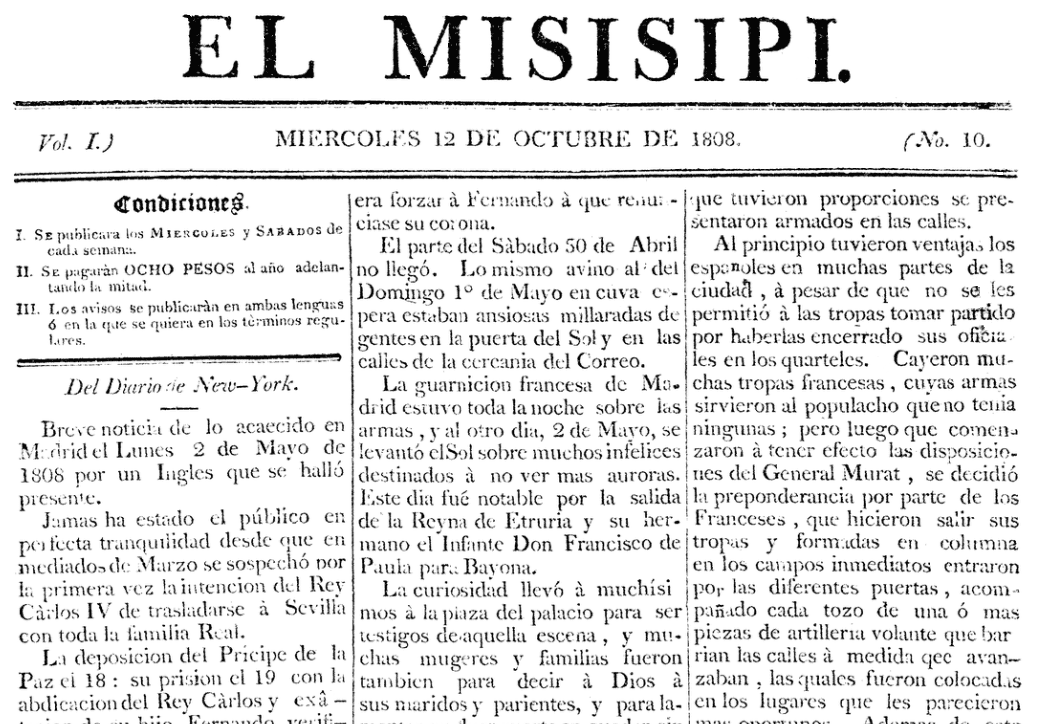Introduction: In this article, to help celebrate National Hispanic Heritage Month (Sept. 15-Oct. 15), Gena Philibert-Ortega writes about the early Spanish-language newspapers available in GenealogyBank, and how they can help with your Hispanic family history research. Gena is a genealogist and author of the book “From the Family Kitchen.”
Ethnic newspapers have historically been an important part of the communities they served. Having access to a newspaper that reflected the community’s concerns and interests, written by people from that community who shared similar experiences and beliefs, was important. Immigrant communities relied on these newspapers to help them learn more about their homelands and their new adopted country.
These newspapers printed articles and information about the local community and its members just like the larger English-language city newspapers that covered these areas. However, in the case of the Spanish-language press, the reporting was done for that specific community and reflected their experience, something that was simply not available from other more mainstream newspapers that reflected often racist viewpoints.
Spanish-language newspapers didn’t just document a community but they also were a forum for educating the population. Intellectuals in places like Louisiana published newspapers to provide information and advocate for their causes. What this means for the family historian is that researching these early Spanish-language newspapers shouldn’t just stop with a search on an ancestor’s name, date, and place – but should instead be studied to better understand the time period and what was of interest to those living in that area.
According to A Brief History of Hispanic Periodicals in the United States by Nikolás Kanellos:
“Since the founding of El Misisipí in 1808, U.S. Spanish-language newspapers have had to serve functions hardly ever envisioned in Mexico City, Madrid or Havana. The Hispanic press has primarily informed the community about current affairs and politics and advertised local businesses and products.” (1)
The First Spanish-Language Newspaper in the U.S.
It probably isn’t a surprise that the first printing press in the Americas was introduced by the Spanish, in 1533, which centuries later led to the first Spanish-language newspaper in the Americas appearing in Mexico City in 1722 (2), followed by the printing of Spanish-language materials in New York and Pennsylvania. (3)
The first Spanish-language newspapers in the United States were published in New Orleans, Louisiana, a city we equate with French influences but was actually the center of the Hispanic press during the 19th century, with 23 Spanish-language newspapers – double that of New York for the same time period. (4)
The first of these newspapers, El Misisipi, began in 1808 and was “aimed at Spanish exiles who opposed Napoleon’s conquest of their native country.” (5)

One important thing to remember about early Spanish-language newspapers is that they may have spanned more than just a small area. Believing that the absence of a newspaper for your ancestor’s city means there’s nothing for your genealogical research would be a mistake. For example, the first Spanish-language newspaper in Los Angeles printed in the years after the Treaty of Guadalupe Hidalgo, El Clamor Publico (1855-1859), was distributed throughout California.
Events such as lynchings of Mexicans and other abuses by the new government led the newspaper to leave its moderate beginnings and reflect a more activist tone. (6) This newspaper, like other Spanish-language newspapers in the United States, was a source of information and politics for everything from the local to national stage.

Other 19th century California Spanish-language newspapers on GenealogyBank include Eco de la Patria, Fe en la Democracia, La Cronica, and Dos Republicas.
As You Research
As you research family history in these early Spanish-language newspapers, keep in mind the importance of understanding your ancestor’s community and concerns as you search out not just genealogical facts but also social history in telling their story. While these very early Spanish-language newspapers may not always provide you the genealogical facts you seek, they provide an important look at your ancestor’s place in time.
________________
(1) “A Brief History of Hispanic Periodicals in the United States” by Nikolás Kanellos, available online at http://docs.newsbank.com/bibs/KanellosNicolas/Hispanic_history.pdf. P. 5
(2) “New Mexico, New Spain, Old cultures: Historic Spanish-Language Newspapers in Chronicling America,” National Endowment for the Humanities (https://www.neh.gov/divisions/preservation/featured-project/new-mexico-new-spain-old-cultures-historic-spanish-language-: accessed 26 September 2019).
(3) “A Brief History of Hispanic Periodicals in the United States” by Nikolás Kanellos, available online at http://docs.newsbank.com/bibs/KanellosNicolas/Hispanic_history.pdf. P. 4
(4) “Spanish Printing in New Orleans: 200 Years and Counting,” Tulane University (https://news.tulane.edu/news/spanish-printing-new-orleans-200-years-and-counting: accessed 26 September 2019).
(5) “Spanish-Language Newspapers from El Misisipi to El Clamor Publico,” USC Libraries (https://libraries.usc.edu/article/spanish-language-newspapers-el-misisip%C3%A3%C2%AD-el-clamor-p%C3%A3%C2%BAblico: accessed 26 September 2019).
(6) “El Clamor Publico Site,” National Park Service (https://www.nps.gov/parkhistory/online_books/5views/5views5h34.htm: accessed 26 September 2019).
Related Articles:
